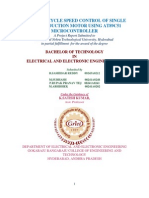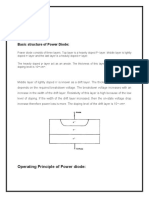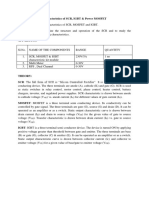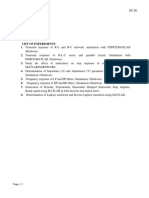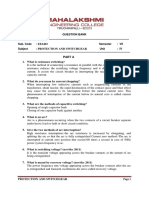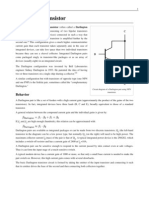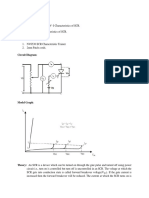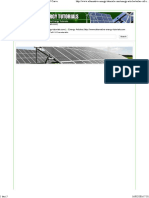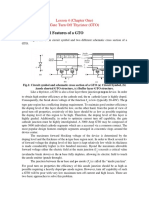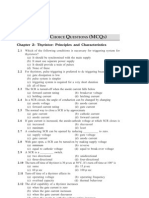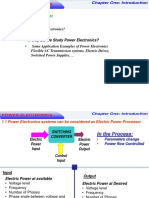Static Induction Thyristor (Sith)
Uploaded by
Rîtzî SaxenaStatic Induction Thyristor (Sith)
Uploaded by
Rîtzî SaxenaSTATIC INDUCTION THYRISTOR (SITH) INTRODUCTION
The static induction thyristor (SITh) or field-controlled diode (FCD) was
first introduced by Teszner in the 1960s. This device is capable of conducting large currents with a low forward voltage and turn-off quickly. It is a self-controlled GTO-like on-off device that was commercially introduced by Toyo Electric Co. (Toyo Denki) of Japan in 1988. It belongs to a family of Static Induction Device and is a high power high frequency power semiconductor device. It is essentially a p+nn+ diode with a buried p+ grid like gate structure. The device structure is analogous to SIT except that a p+ layer has been added to the anode side.
Fig. 1
Fig. 2
Static induction devices
There are many devices which belong to the static induction devices family: Static Induction Transistor (SIT), Static Induction Diode (SID), Static Induction Thyristor, Static Induction Transistor Logic (SITL), Static Induction MOS Transistor (SIMOS)
STATIC INDUCTION THYRISTOR (SITH)
Features
Since they are normally on-state, gate electrodes must be negatively biased to hold off-state. The SI-thyristor at on-state behaves similar to pin diodes. The on-state voltage is low in the Si-thyristor, which is due to thyristor action followed by carrier injection effect around the gate channel. Minority-carrier device (a JFET structure with an additional injecting layer). Power-handling capability similar to GTO. Faster switching speeds than GTO. Level-triggered and Voltage-driven (voltage-controlled) devices.
Fabrication
Many interesting works have been done on fabricating different structures of SITH to improve its forward blocking and switching characteristics , such as anode-shorting pattern , shallow-junction pattern and double-gate pattern.
Fig. 3 Surface plan view of the fabricated SI thyristor
STATIC INDUCTION THYRISTOR (SITH)
BASIC STRUCTURE OF SITH
Fig. 4
Basic structural types of SITH had been developed in recent years, such as buried gate, surface gate, recessed gate, double dielectrics gate and buried-gate with diffused source region (DSR buried-gate). It is normally ON state device, i.e if the anode is positive and the gate voltage is zero, the device will behave like a diode and current will flow freely. The forward biasing of the P+ N junction will cause a hole injection into the region N- region and its conductivity will be modulated. When the gate is reversed biased with respect to cathode, a depletion layer will block Anode current. As a results device gets OFF. Evidently it is not a thyristor like structure like trigger into conduction device but somewhat SIT like V-I characteristics with varying Negative gate biase.
STATIC INDUCTION THYRISTOR (SITH)
WORKING
ON-STATE
When a positive voltage pulse is applied to the gates, the depletion region is filled with carriers and the device becomes on-state. The transition time of the turn-on process is largely dominated by the rate of the carrier injection time. At the turn-on phase the SI-thyristor acts just like as a pin-diode
OFF-STATE
Since SITh is normally ON state, the gate electrodes have to be negatively biased. The negative bias voltage to the gate forms a low-conductive depletion region around the gates and the SI-thyristor holds off-state.
STATIC INDUCTION THYRISTOR (SITH)
Some examples
Type
4kV/300A
4kV/600A /400A Ceramics Sheered type (Reverse Conducting)
5.5kV/600A /400A
4kV/30A
Package
Ceramics Sheered type
Ceramics Plastic Mold Sheered type type (Reverse Conducting)
Outside view
Applications Inverter Pulsed power
Inverter Pulsed (Soft Switching) power
Pulsed power Inverter
STATIC INDUCTION THYRISTOR (SITH)
ADVANTAGES AND DISADVANTAGES
Advantages of SITh
The device has also high immunity for electromagnetic noise. SITh has high di/dt and dv/dt critical ratio. capable of handling rapid voltage or current changes. Its a vertical structure device with short multichannel. Being a vertical device, the SITh offers advantages in obtaining higher breakdown voltages than FET.
Disadvantages
One of the disadvantages of the SIT is the relatively flat shape of the potential barrier. This leads to slow, diffusion based transport of carriers in the vicinity of the potential barrier.
STATIC INDUCTION THYRISTOR (SITH)
SPECIFICATIONS
Short channel length Low gate series resistance Low gate source capacitance Small thermal resistance Low noise High audio frequency power capability
The forward blocking voltage of this SITH has been increased to 1600 V from the previous value of 1000 V, The blocking gain increased from 40 to 70,
A high anode blocking voltage VAK and switching speed are necessary parameters for SITH with good performance.
Applications
Due to its high switching speed, high di/dt and dv/dt capabilities, along with a low forward on state voltage (Von), SITH has been used in systems of energy accelerator, current-source inverter and high-frequency power conversion, etc.
STATIC INDUCTION THYRISTOR (SITH)
References
www.wikipedia.org Present status of SIThy shimizu,sekiya,Iidal NGK insulators Power electronics handbook by M.Rashid Recent development of the SIThy and its applications Evaluation of Modern Power Semiconductor Devices and Future Trends of Converters by Bimal K. Bose, Fellow, ZEEE
You might also like
- Integral Cycle Speed Control of Single Phase Induction Motor.50% (2)Integral Cycle Speed Control of Single Phase Induction Motor.47 pages
- Difference Between Power and Small Signal DiodeNo ratings yetDifference Between Power and Small Signal Diode4 pages
- Difference Between Enhancement Type and Depletion Type MOSFETNo ratings yetDifference Between Enhancement Type and Depletion Type MOSFET3 pages
- Sumpners Test On A Pair Of 1-Φ Transformers: Experiment - 2No ratings yetSumpners Test On A Pair Of 1-Φ Transformers: Experiment - 24 pages
- Experiment 4 - Three Phase Uncontrolled RectifierNo ratings yetExperiment 4 - Three Phase Uncontrolled Rectifier13 pages
- Transistor Series Voltage Regulator or Emitter Follower Voltage Regulator100% (1)Transistor Series Voltage Regulator or Emitter Follower Voltage Regulator2 pages
- Micro Project Report: Title:Characterstics of TRIACNo ratings yetMicro Project Report: Title:Characterstics of TRIAC14 pages
- Thyristor Controlled Reactor: Circuit DiagramNo ratings yetThyristor Controlled Reactor: Circuit Diagram4 pages
- Magnetic Amplifier in Series: Operation ManualNo ratings yetMagnetic Amplifier in Series: Operation Manual6 pages
- 6.v-Curve & Inverted V-Curve For Three Phase Syncronous Motor100% (1)6.v-Curve & Inverted V-Curve For Three Phase Syncronous Motor6 pages
- Micro and Nano Scale Sensors and Transducers 18EE732 Jan-Feb 202367% (3)Micro and Nano Scale Sensors and Transducers 18EE732 Jan-Feb 20232 pages
- Design and Application Guide For High Speed MOSFET Gate Drive CircuitsNo ratings yetDesign and Application Guide For High Speed MOSFET Gate Drive Circuits37 pages
- Power Electronics Lab Experiment-No. 6 Single-Phase Full and Half Wave Controlled SCR Rectifier Aim: To Study and Analyze The Properties and The Characteristics of A Single-PhaseNo ratings yetPower Electronics Lab Experiment-No. 6 Single-Phase Full and Half Wave Controlled SCR Rectifier Aim: To Study and Analyze The Properties and The Characteristics of A Single-Phase6 pages
- Experiment No. 3: Characteristics of CMOS InverterNo ratings yetExperiment No. 3: Characteristics of CMOS Inverter6 pages
- Current Components and Law of Junction (17.8.20)No ratings yetCurrent Components and Law of Junction (17.8.20)22 pages
- Solar Cell I-V Characteristic and The Solar Cell I-V CurveNo ratings yetSolar Cell I-V Characteristic and The Solar Cell I-V Curve5 pages
- Introduction to Static Induction TransistorsNo ratings yetIntroduction to Static Induction Transistors8 pages
- A New Static Induction Thyristor (Sith) Analytical Model: Jue Wang and Barry W. WilliamsNo ratings yetA New Static Induction Thyristor (Sith) Analytical Model: Jue Wang and Barry W. Williams11 pages
- IES - Electrical Engineering - Power Electronics100% (1)IES - Electrical Engineering - Power Electronics35 pages
- Power Electronics 2nd Edition Dr M D Singh - Quickly access the ebook and start reading today100% (1)Power Electronics 2nd Edition Dr M D Singh - Quickly access the ebook and start reading today61 pages
- Lecture One_2_power Semiconductor DevicesNo ratings yetLecture One_2_power Semiconductor Devices74 pages
- Constructional Features of A GTO: Lesson 4 (Chapter One) Gate Turn Off Thyristor (GTO)No ratings yetConstructional Features of A GTO: Lesson 4 (Chapter One) Gate Turn Off Thyristor (GTO)3 pages
- Current Commutated Chopper Through Simulink100% (1)Current Commutated Chopper Through Simulink54 pages
- Comparison of Wide-Bandgap Semiconductors For Power Electronics ApplicationsNo ratings yetComparison of Wide-Bandgap Semiconductors For Power Electronics Applications34 pages
- Question No. 4: Explain Maximum Power Point Tracking and Its Importance in PV Based Systems. (Ali-Chap5)No ratings yetQuestion No. 4: Explain Maximum Power Point Tracking and Its Importance in PV Based Systems. (Ali-Chap5)13 pages
- 430 15EC73 Power Electronics Notes (Vtupro Com) 2No ratings yet430 15EC73 Power Electronics Notes (Vtupro Com) 2100 pages
- Power Quality Improvement of Non-Linear-1337No ratings yetPower Quality Improvement of Non-Linear-13378 pages
- Special Topics - Midterm Electronics Part 5No ratings yetSpecial Topics - Midterm Electronics Part 56 pages
- Electric Locomotive, Diesel Electric and Hybrid Locomotive100% (1)Electric Locomotive, Diesel Electric and Hybrid Locomotive9 pages
- The Silicon-Controlled Rectifier (SCR) - ThyristorsNo ratings yetThe Silicon-Controlled Rectifier (SCR) - Thyristors12 pages
- Power Electronics Ned Mohan Slides Ch26No ratings yetPower Electronics Ned Mohan Slides Ch2644 pages
